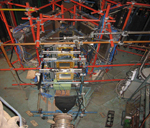|
STRUCTURE
ACTIVITIES
ACHIEVEMENTS
PUBLICATIONS
EVENTS
HISTORY
USEFUL INFORMATION
SOCIAL LIFE
|
|
 |
 |
I n t e r m e d i a t e E n e r g y P h y s i c s
(continued - page 3)
Experiments at NRC KI - ITEP
PNPI Group Leader: V.V. Sumachev
To extend measurements of the spin rotation parameters A and R to the second resonance region of pion-nucleon scattering, similar experiments were carried out at the pion channel
of the ITEP
accelerator. Measurements of the spin rotation parameters A and R are the key experiments in the whole program of studying the elastic pion-proton scattering since only such measurements permit to remove discrete ambiguities arising in the course of a partial-wave analysis (PWA) if experimental data on the spin rotation parameters are absent. Planning of these experiments was made taking into account results of PWAs existing to the moment of starting experiments.
To carry out the experiment on measurements of the spin rotation parameters A and R,
at PNPI a polarized proton target of special type – with the vector of proton polarization lying in the horizontal plane – was created and a proton polarimeter for measuring the asymmetry of the secondary scattering of the recoil protons by nuclei of a substance-analyzer was built. The spin rotation parameters A, R for elastic pion-proton scattering were measured at ITEP at three momenta of the incident pions: 1000, 1430 and 1620 MeV/c. Measurements were performed by PNPI scientists and engineers in collaboration with physicists of ITEP. One of the most interesting results is the fact that experimentally measured values of the parameter A agree well with the predictions of the PWA performed by the group of physicists from the George Washington University and contradict to the PWAs KH and CMU-LBL. Since all the characteristics of pion-nucleon resonances presented in Listings of the Review of Particle Physics are obtained just on the base of the analyses KH and CMU-LBL, which seem to be not entirely correct in the light of our last experimental data, it is necessary to revise and specify these fundamental constants by means of performing a new partial-wave analysis with inclusion our new experimental data on the spin rotation parameters.
At the pion channel 322 of the ITEP synchrotron, which has high momentum resolution
(better than 0.1%), a new experiment “EPECUR” is underway. Its goal is to search for exotic baryonic resonance – a non-strange member of the “pentaquark” antidecuplet P11 with expected mass about
1700 MeV.

The experiment is carried out by scanning the invariant mass of the pion-proton system in the range 1620–1770 MeV.
In 2008, tuning of the pion channel 322 was completed, the experimental setup was fully put into operation, and we started the first stage of experiment (fig.1), at which a search for the narrow exotic resonance is being performed in the reaction of elastic pion-proton scattering.
To begin of 2012 year the statistics of 2.97 billion events was collected. The distribution of the collected triggers over runs and beam momentum intervals is at (fig.2.)
Preliminary results on the differential cross section measurements as a function of the incident momentum for 5-degree the center of mass intervals are shown in fig. 3.
These data points correspond to the analysis of about 15% of the statistics already collected. Some irregularity is manifested at beam pulse 1020–1040 MeV/c. The nature of this irregularity could be either a narrow resonance with the mass around 1690 MeV and width of 5–10 MeV, or a threshold effect, caused by opening of the channels of neutral K-meson production (mass 1690.2MeV) and positive charging K-meson production (mass 1691.1 MeV).
(For more detail review see
"Experiments at ITEP ")

|
 |
 |